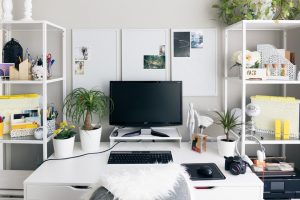Subtotal: $157.11

During the pandemic, many individuals adjusted to working from home, and 68 percent of remote workers say they don’t want to return to the office. Surprisingly, 58 percent of workers say they would even consider switching jobs if they had to give up remote work.
However, most people would agree that to be successful and stay motivated, having the right home office setup is essential. If you’re designing your home office, we encourage you to keep reading as we share some of the most common home office setup mistakes and some tips to help you avoid them!
Many people are tempted to choose a desk simply because they like the material or style, only to find out that it doesn’t meet their needs.
For example, if you plan on connecting a keyboard to your laptop, you’ll need a desk that’s large enough to accommodate one. Students or remote workers who need to keep a lot of files or books on hand should consider a desk with drawers or cubbies. And if you’re trying to stay more active, you might want a standing desk that allows you to switch between sitting or standing.
Thankfully, you can usually find the right desk in a style you love, whether that’s modern or rustic home furniture!
Did you know that most desks are designed for people between 5’6″ and 5’11”? If you are shorter or taller, you won’t be able to rest your arms properly on the surface, making you uncomfortable.
Similarly, your desk chair may not be comfortable if you don’t choose one that suits your body. Consider aspects like lumbar support, adjustable height, armrests, and back height to determine which types of office chairs are best for your working style.
Make sure you feel comfortable, no matter what style desk or chair you choose. If not, you’ll end up with aches and pains, headaches, or other health problems that will make it difficult to be productive.
Many remote workers prefer laptops, but looking down for hours can take a toll on your neck and back. Experts recommend keeping your computer screen at eye level, roughly 20 to 30 inches from your face.
If possible, switch to a desktop or connect your laptop to a monitor while working. Another option is to purchase a laptop stand and use it along with a standard mouse and keyboard. Either way, your spine will thank you!
Home offices easily gather clutter, such as stacks of paperwork, books, or other stationery items. It’s best to plan for this by designating a space for items you use often.
Drawers or shelves near your desk can help you keep everything in its place, preventing you from misplacing items often. Alternatively, rolling carts are great solutions if your desk lacks drawers and serves as home office file storage.
The right lighting can make a huge difference in your mood, especially during the winter months. If possible, place your desk near a window so you can soak up natural light while you work. You’ll likely feel more energized and motivated to get tasks done.
If your home office is dark, opt for warm lighting instead. In addition to a ceiling light, invest in a desk lamp so you have plenty of office lighting options and can adjust the brightness of the room as needed.
Most remote workers or students spend hours on video calls every week. If Zoom meetings are a typical part of your work week, make sure your home office background is professional.
One way to do so is by placing a bookcase behind your desk and putting decorative items or plants on the top shelves that people will see during a video call. You can place anything you want to keep off-camera on the lower shelves.
If you don’t have an entire room to designate as your home office, be careful where you place your desk. The living room may be a good option if you live alone, but if you have roommates or children, there may be a lot of distractions. If possible, choose a quiet space to which only you have access.
There’s nothing worse than tangled cords cluttering up the top of your desk or creating a rat’s nest underneath. Although many people forget to include a cable management system in their setup, doing so will help you stay organized and quickly find the right cable.
The best cable management systems attach to the underside of the desk, separating each cable. You can also use bread tags or tape to label your cords.
Another option is to choose Bluetooth accessories when possible since this limits the number of cables on your desk.
Coming up with the right office setup is personal since we each have unique preferences and work styles. So, while we can’t tell you which desk or chair to choose and how to arrange your office, we can help you avoid some of the most typical home office setup mistakes.
We recommend saving this post to help you as you plan your workspace. And, if you’d like some inspiration or help coming up with home office designs, browse the posts on our blog! You’ll find guides that help you choose furniture that meets your needs and looks great.